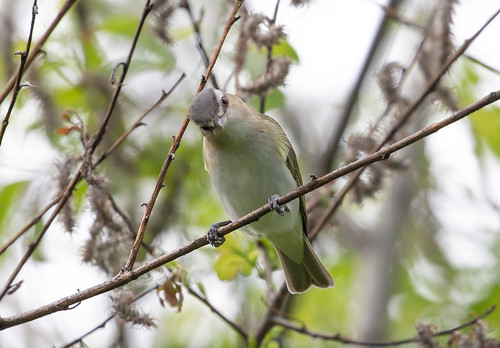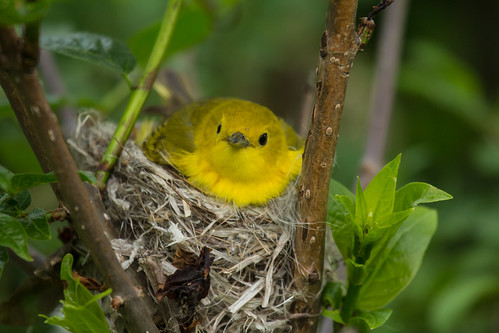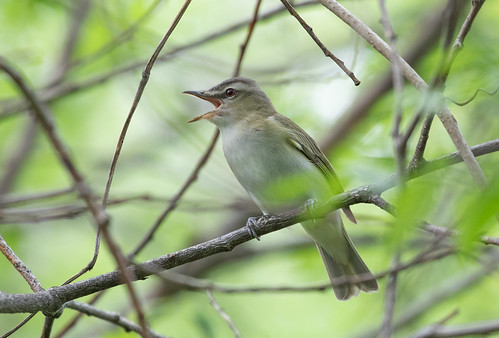It’s officially summertime now, but the livin’s not so easy, at least not for the birds among us. We humans tend to think of winter as the hard season for birds—at least for those who stick around the frigid Northland—but the worst January doesn’t hold a candle to June when it comes to sheer exhausting work from sunup to sundown. Short winter days do make it tricky for birds to get enough calories to stoke their metabolic fires to stay alive over those exceptionally long winter nights, but once they fall asleep, they can rest easy through all those long hours until the next morning.
Even during our shortest summer nights, birds are not resting easy. I’ve been recording my backyard birds every non-raining morning since April 29. No matter how early I start, even when it’s over an hour before sunrise, my robins are already singing, and House Wrens and chickadees are also singing up a storm way before sunrise. Robins take a break from singing as soon as they get enough light to search for worms, but even with family responsibilities, they have to break into song on and off all day long to remind their neighbors of proper social distancing rules.
Birds with young to raise spend these longest days of the year, from sunrise to sunset, searching for food for their little ones, or incubating eggs. Sitting on a nest sounds so restful, but birds burn a LOT of calories to hold those eggs at a steady hundred degrees or so. In some species where the female does all the incubating, the male does most of the baby-feeding when they hatch, so mom can get herself back into condition before they start all over again. While he waits for the eggs to hatch, he's busy singing to warn other males off his territory and to remind his mate that he's a pretty talented and sturdy guy.
Of course, not all birds have managed to find a mate and settle in yet. But those unemployed “floaters” are pretty darned busy searching for work. For a while in May, a couple of male Brown Thrashers turned up in my yard. One dominated and won the territory. He spent long hours singing his heart out but didn’t manage to attract a mate, so he moved on. If he hasn't found a mate, I am sure he's still singing and searching.
Red-eyed Vireos turned up in my yard now and then in late May, starting May 23. I made a 48-minute recording of a Red-eyed Vireo on June 16. Before that day, I hadn’t heard a vireo in twelve days, not since June 4. I suspect females shy away from this corner of Peabody Street because there’s a nearby crow nest—I’m pretty certain that crows raided last year’s nest to feed their chicks. Anyway, this vireo turned up on the 16th and broke into song that lasted for well over an hour and a half. Tragically, I hadn’t realized my 256-gigabyte memory card was getting low on space and my recorder shut down 48 minutes after his song bout started, so I don’t know how much of that solid singing bout I missed—he was still going strong for over a half hour after I discovered my recorder had stopped. I counted 416 songs one-by-one during his first 10 minutes, extrapolating to about 2,000 songs over just the 48 minutes I recorded. I’m betting he sang at least 4,000 songs in that single round of singing, and wish I could have documented it. If any females had been hiding out around here, they certainly had to realize that a strong, virile Red-eyed Vireo was available, but apparently none were. The next day I made sure to have fresh batteries and an entirely erased memory card in my recorder, but the male had moved on in search of a receptive listener of the vireo, not human, persuasion.
These daily recordings are making it very clear to me that right when I think the birds in my neighborhood have settled in, many individual adults are still moving about trying to establish a territory and find a mate. Some may have arrived late; some may be immatures who are still learning the ropes, and some may have lost their first mate or young and they’re hoping to start anew.
On June 20—the first day of summer, my recorder captured a catbird singing (I hadn’t heard one of those in four days), a Rose-breasted Grosbeak (last time I had one of those was way back on May 25, almost four full weeks ago), and a Great Crested Flycatcher (I hadn't heard one of them since June 12). None of them sang very long—if my recorder hadn’t captured the songs, I’d have had to be outside at the right moments to even notice.
Anyway, it’s officially summer now, and whether or not they already are raising young, birds are all doing their part to ensure that there will be lots of birds in the future. Doing our part—making our windows bird safe, keeping cats indoors, avoiding lawn and garden pesticides, planting native trees, shrubs, and flowers, making sure our bird feeding practices do much more good than harm, and things like that—will not just help birds in general, Just as importantly, it will ease the lives of the very birds who make our own summertimes so richly wonderful.





